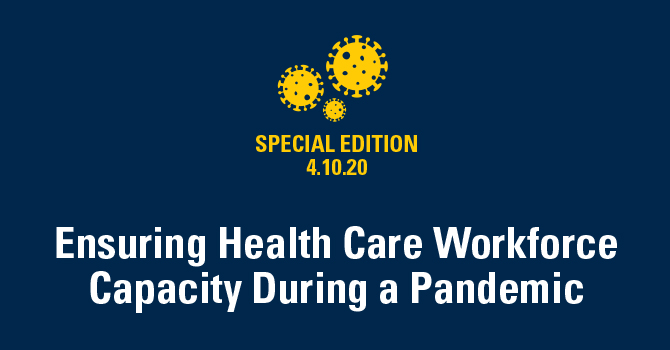Ensuring Health Care Workforce Capacity During a Pandemic

In addition to limited supplies of hospital beds, ventilators, masks, and other personal protective equipment, there is another limited—yet vital—health care resource needed to help us get through this pandemic: The workforce of doctors, nurses, respiratory therapists, and others who are putting their own health at risk to care for patients. Angela Beck, a clinical assistant professor of Health Behavior and Health Education at the University of Michigan School of Public Health, explores what policy makers and hospitals can do to keep health care workers safe and healthy and ensure the workforce can meet the growing demands on the health care system.
Listen to "Ensuring Health Care Workforce Capacity During a Pandemic 4.10.20" on Spreaker.
|
Subscribe and listen to Population Healthy on Apple Podcasts, Spotify, Google Podcasts, iHeartRadio, YouTube or wherever you listen to podcasts! Be sure to follow us at @umichsph on Twitter, Instagram, and Facebook, so you can share your perspectives on the issues we discussed, learn more from Michigan Public Health experts, and share episodes of the podcast with your friends on social media. |
Speaker 1: The construction and deployment of masks, ventilators, and other personal protective equipment has become daily fatter for the news cycle. While these resources represent one dimension of care during this pandemic, there is another one to worry about: the workforce of doctors, nurses, respiratory therapists, home health aids, nursing assistants, and others who are putting their own health at risk to care for patients during this crisis. How can we make sure there are enough healthcare workers to meet the growing demands on the healthcare system? And how do we help those workers stay safe and healthy in the process?
Hello and welcome to Population Healthy, a podcast from the University of Michigan School of Public Health. This episode as part of a series of special editions of our podcast, focusing on the ongoing coronavirus pandemic. To learn more about the impact of this pandemic on the healthcare workforce, we talked with Angela Beck, a clinical assistant professor in the department of Health Behavior and Health Education at the University of Michigan School of Public Health and the principal investigator and director of the Behavioral Health Workforce Research Center.
Beck: Right now during the coronavirus pandemic, provider supply is being threatened by lack of sufficient personal protective equipment, the need for some workers to isolate or quarantine themselves due to illness or a possible illness, and worker fatigue and burnout. And because we're still learning about the virus and who is most susceptible and most at-risk, providers are responding to a rapidly changing situation. States are actively developing staffing models and calculating needed provider-to-patient ratios for multiple scenarios of care. There are several policy levers that can be pulled to help increase workforce capacity. Federal agencies and state governments are rapidly considering the many policy options and regulatory authorities available to them to help flex and surge the healthcare workforce. Flexing the workforce typically involves strategies to use the worker supply that we already have most efficiently, even task shifting when needed. Workforce surge considers how to expand and supplement the existing workforce.
So these can prompt different but overlapping strategies and some of those include modifying licensing regulations and other federal policies, re-deploying workers, recruiting volunteers and health profession students, adjusting accreditation standards to ensure that the health profession students who are really within months of graduating right now are able to do so and join the workforce. And then there are things like implementing waivers to Medicare and Medicaid restrictions to ensure that there's payment for provider services that are offered in a variety of sites during this time.
Speaker 1: With certain states like New York and Michigan, expected to reach the peak of their case as sooner than others, some are calling to send healthcare workers from other states to high-need states. Could that actually work? And what are the other strategies states and hospitals could use to address workforce shortages?
Beck: The redistribution and deployment of workers to areas of high need is certainly an important strategy. A couple of things that I would keep in mind from the perspective of the healthcare provider are license portability, so are they authorized to practice in the state of New York depending on the type of healthcare provider they are and are there supports in place to ensure worker safety as much as possible?
We also wanna be mindful of making sure we aren't pulling too many resources from vulnerable communities that may need that support later. So in times of emergency, like this, we think about all options being on the table to surge the workforce, but sometimes they're regulatory and other barriers that need to be overcome, first.
Some states and hospitals are rapidly enacting plans to distance the frontline workers who are treating COVID-19 and their patients to separate areas. So, we see sections of hospitals, reserved for COVID-19 cases and the suspension of non-essential medical visits to try to limit exposure to the virus for other health care personnel. So it's a strategy of using all possible authorities to get the protective equipment needed for healthcare workers and also containing exposure to the virus as much as possible.
Preparing for under-staffing due to illness is certainly a key consideration. We don't yet know the true incidence and prevalence of COVID-19 specifically in clinical settings, but we know the wellness of the workforce should be top of mind. A leading health workforce researcher at the University of Washington, Dr. Bianco Frogner, just released estimates of the potential effect of COVID-19 on the healthcare workforce based on the experience of other countries. It's substantial, and it really underscores the need to protect our healthcare workforce.
This is why social distancing is so critically important. We emphasize flattening the curve because if we exceed the capacity of our workforce to treat cases the morbidity and mortality associated with this disease will rise exponentially.
The best ways we can minimize risk to our health care workers are to ensure that they have access to screening tests, so they know whether they've contracted the virus and can take appropriate care procedures, get them the personal protective equipment that they need, and follow social distancing orders. Stay home to reduce the spread of disease.
I think there's a great opportunity to learn right now. Sometimes the system innovates out of necessity in times of emergency. As has been noted by others, the COVID-19 pandemic has exposed the deep cracks in the foundation of our healthcare system that have always existed and has exacerbated them. In this time of crisis and uncertainty, there's opportunity to mend some of those cracks with regulatory changes. We might find that some of these shifts should not be temporary, but could actually advance our national efforts longer-term to provide more equitable and effective healthcare to all who need it.
Speaker 1: This has been a special edition of Population Healthy, a podcast from the University of Michigan School of Public Health. During the ongoing coronavirus pandemic, we’ll work to bring you analysis from our community of experts to help you understand what this public health crisis means for you. To stay up-to-date in between special edition episodes, be sure to check out our website publichealth.umich.edu, subscribe to our Population Healthy newsletter at publichealth.umich.edu/news/newsletter and follow us on Twitter, Instagram, and Facebook @umichsph
In This Episode
 Angela Beck
Angela Beck
Clinical Assistant Professor of Health Behavior and Health Education
Angela Beck is a clinical assistant professor of Health Behavior and Health Education and director of the Behavioral Health Workforce Research Center at the University of Michigan School of Public Health. Her research interests include organizational performance of public health departments, workforce development, health workforce planning, and delivery of mental health and substance use disorder services to vulnerable and underserved populations. She is currently exploring emergency workforce policy options to support health workforce surge capacity during the coronavirus pandemic.
